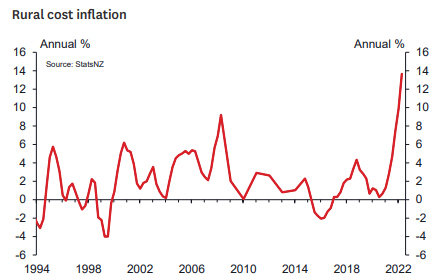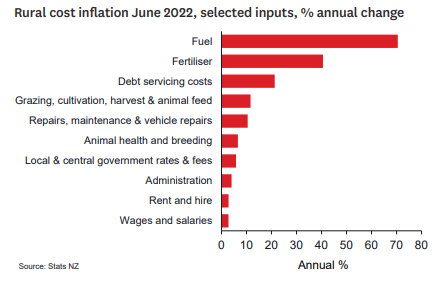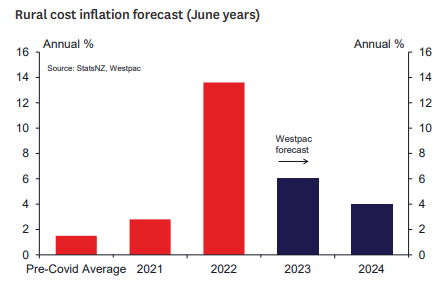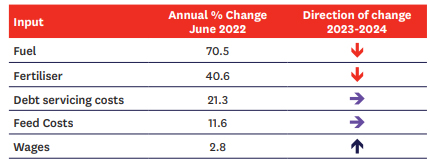
By Nathan Penny and Satish Ranchhod*
– Cost inflation in the rural sector hit boiling point over the past year, with costs rising by more than 13% in the twelve months to June.
– We expect cost inflation to moderate over the year ahead, with the prices for many imported inputs (such as fuel and fertiliser) easing back in recent months.
– Even so, farmers are likely to see sizeable increases in their operating costs over the coming years.
– Meanwhile, the drivers of those price increases are set to change from global factors to local drivers, such as wages and feed prices.
– Indeed, with strong growth in agricultural incomes in recent years
– and related strong demand for inputs
– we expect to see ongoing pressure on operating costs.
Rural cost inflation has boiled over
Cost inflation in the rural sector hit boiling point over the past year. Input prices across all farm and orchard types1 (excluding livestock costs) rose by a whopping 13.7% in the twelve months to June. That rise came on top of the 9.9% annual change recorded in March, which itself was also a record high (Stats NZ reports this data as far back as 1994).
Operating costs have been rising for businesses right across the economy. However, the rise in farm costs has been particularly large, with input costs for businesses more generally rising by 'only’ 10% over the past year.

The inflation surge was broad-based. Of the 21 inputs reported by Stats NZ, all but one (electricity) posted price rises in annual terms.
The key drivers of input inflation over the past year have been fertiliser, debt servicing costs, fuel, and feed prices. Fuel prices led the surge, skyrocketing 70.5% over the year. Fertiliser prices also surged, spiking by over 40% over the year to June. Meanwhile, debt servicing costs have lifted around 21% in percentage terms over the year, while feed prices are up roughly 12%. Looking at feed, while the price lift is more moderate compared to say fuel, feed makes up a larger share of farmer costs and therefore makes a large contribution to the overall lift in input prices.

Looking by farm type, dairy farms experienced the biggest jump in input costs, with prices up nearly 16% over the period. Sheep and beef farmers and cropping farmers experienced the next biggest lift, with prices lifting around 13%, while for horticulture, prices were up closer to 10% for the year.
From here, cost inflation is coming off the boil…
From here, we expect cost inflation to come off the boil. In other words, we anticipate that the 13.7% spike in annual terms will market the peak rate of inflation in this cycle.
Indeed, some of the key inflation drivers are already coming off their highs. Oil prices, for example, have dropped from over US$120/barrel in June to around US$95/barrel currently. In addition, global urea prices have fallen over US$300/metric ton, or by around a third from their peak in April.
… but we expect it to simmer for a while
However, we still expect sizeable increases in prices over coming years. By June 2023 and June 2024, we expect annual cost inflation to slow to between 4% and 6%. While that’s a material slowing, it is noticeably higher than the 1% and 2% average prior to the Covid outbreak.

Indeed, the drivers of cost inflation are changing. From here, we anticipate that local factors will begin to dominate the earlier price lifts that we saw primarily from offshore sources. Specifically, we expect wages and local feed prices (grazing, seeds, harvesting etc.) to accelerate or at least remain high over the coming years.

With high farm and orchard gate prices and related strong demand for inputs, we expect to see ongoing pressure on operating costs. That firmness in demand means that suppliers are likely to continue to pass on price increases for farming inputs.
In the case of wages, the ongoing pressures reflect the wider strength in the labour market. Signs of wage pressures have already bubbled to the surface, with the June quarter showing the highest wage increases since 2008. More broadly, the unemployment rate is at 3.3% and is just 0.1% shy of the record low. In addition, workers are seeking compensation for high inflation, with most workers’ inflation-adjusted wages falling over the past year or so. Ongoing increases to the minimum wage are also adding to the pressures.
On this basis, it pays for farmers and growers to remain vigilant around the management of cost pressures, as these pressures are likely to remain high for a considerable period yet.
This article is a re-post of Westpac's Economic Bulletin by Nathan Penny and Satish Ranchhod. It is here with permission.





We welcome your comments below. If you are not already registered, please register to comment.
Remember we welcome robust, respectful and insightful debate. We don't welcome abusive or defamatory comments and will de-register those repeatedly making such comments. Our current comment policy is here.